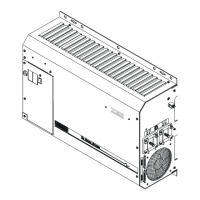INSTALLATION
Page
22
Copyright Trace Engineering Company, Inc.
5916 - 195th Street N.E.
Arlington, WA 98223
Telephone: 360/435-8826
Fax: 360/435-2229
www.traceengineering.com
PS Series Inverter/Charger
Part No. 3597
Rev. D: November 23, 1999
DC DISCONNECT AND OVERCURRENT PROTECTION
For safety and to comply with regulations, battery over-current protection is required. Fuses and
disconnects must be sized to protect the wiring in the system. The fuse or disconnect is required to open
before the wire reaches its maximum current carrying capability.
For residential and commercial electrical systems, the National Electrical Code requires both overcurrent
protection and a disconnect switch. These installation parts are not supplied as part of the inverter.
However, Trace Engineering offers a DC rated, UL listed, circuit breaker disconnect specifically designed
for use with Trace inverters for applications requiring NEC compliance. Two amperage ratings are
available - a DC250 (250 amps) and a DC175 (175 amps). These disconnects are available in a single or
double pole configuration to handle either one or two inverters. The DC disconnect enclosure will
accommodate up to four smaller breakers for use as DC load disconnects, PV array disconnects, etc. and
the top is designed to allow direct connection of up to two Trace Engineering charge controllers. The
Trace DC disconnect is not designed to accept doubled (paralleled) cables which may be required for
long cable runs. Also, the plastic red and black covers on the end of the inverter are not designed to
accommodate dual cables. If dual cables are used, the optional conduit box (PSCB)) should be used.
When sizing the DC disconnect, the expected continuous load on the inverter is used to determine the
DC current involved. You must account for the efficiency loss through the inverter, which increases the
DC current draw. Divide the maximum continuous current draw by the lowest efficiency to determine the
DC current, a 25% safety margin should be included to comply with the code requirements. When a
breaker has been selected as the overcurrent device, tighter sizing may be acceptable since the breaker
is more easily reset when compared to a high current, bolt-in type fuse.
Some installations may not require conduit or a means of disconnection, although overcurrent protection
(fuse) is still required. Trace Engineering offers a fuseblock (TFB) that provides the code required inverter
overcurrent protection for these applications.
TFB’s include a fast acting, current limiting class-T fuse to protect your battery, inverter and high
amperage cables from damage by short circuits and overloads. This fuse provides extremely fast
protection when a short circuit occurs. When properly selected, it also has a time delay that allows the
inverter to surge to full power without blowing the fuse. A slide off cover prevents accidental contact with
the fuse’s live terminals. For maximum protection, install the fuseblock within 18 inches (45 cm) of the
battery. The fuses are available in 110, 200, 300, and 400 amp sizes.
Use Table 3 below, to determine the proper size disconnect (breaker) or fuse for the battery cables you
are using. These recommendations may not meet all local code or the NEC requirements, consult your
applicable electrical code for more information regarding acceptable fuse and cable sizes.
Table 3, Battery Cable to Maximum Breaker/Fuse Size
CABLE SIZE
REQUIRED
RATING IN
CONDUIT
MAXIMUM
BREAKER SIZE
RATING IN
“FREE AIR”
MAXIMUM
FUSE SIZE
00 AWG 175 amps 175 amps 265 amps 300 amps*
0000 AWG 250 amps 250 amps** 360 amps 400 amps*
* The NEC allows rounding up to the next standard fuse size from the cable rating, i.e. 150-amp
cable size rounds up to a standard 175-amp size. The term "free air" is defined by the NEC as
cabling that is not enclosed in conduit or a raceway. Cables enclosed in raceways or conduits have
substantially lower continuous current carrying ability due to heating factors.
** Nuisance tripping is possible if operated at 2.5 kVA continuously with a 250-amp breaker
Contact your Trace dealer to order the inverter disconnects/fuses or see the OTHER PRODUCTS section
on page 129 for more information.

